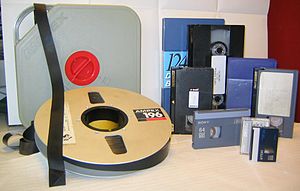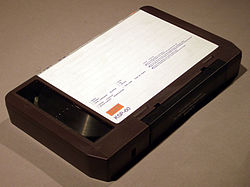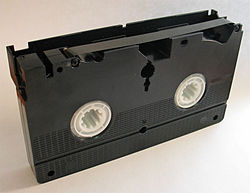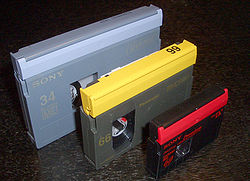- Videotape
-
A videotape is a recording of images and sounds on to magnetic tape as opposed to film stock or random access digital media. Videotapes are also used for storing scientific or medical data, such as the data produced by an electrocardiogram. In most cases, a helical scan video head rotates against the moving tape to record the data in two dimensions, because video signals have a very high bandwidth, and static heads would require extremely high tape speeds. Videotape is used in both video tape recorders (VTRs) or, more commonly and more recently, videocassette recorder (VCR) and camcorders. Tape is a linear method of storing information and, since nearly all video recordings made nowadays are digital direct to disk recording, it is expected to gradually lose importance as non-linear/random-access methods of storing digital video data become more common.
Information stored can be in the form of either an analog signal or digital signal.
Contents
Early formats
The electronics division of entertainer Bing Crosby's production company, Bing Crosby Enterprises (BCE), gave the world's first demonstration of a videotape recording in Los Angeles on November 11, 1951. Developed by John T. Mullin and Wayne R. Johnson since 1950, the device gave what were described as "blurred and indistinct" images, using a modified Ampex 200 tape recorder and standard quarter-inch (0.6 cm) audio tape moving at 360 inches (9.1 m) per second.[1][2] A year later, an improved version, using one-inch (2.6 cm) magnetic tape, was shown to the press, who reportedly expressed amazement at the quality of the images, although they had a "persistent grainy quality that looked like a worn motion picture". Overall, the picture quality was still considered inferior to the best kinescope recordings on film.[3] Bing Crosby Enterprises hoped to have a commercial version available in 1954, but none came forth.[4] BCE demonstrated a color model in February 1955, using a longitudinal recording on half-inch (1.3 cm) tape, essentially similar to what RCA had demonstrated in 1953 (see below). CBS, RCA's competitor, was about to order BCE machines when Ampex introduced the superior Quadruplex system (see below).[5]
RCA demonstrated the magnetic tape recording of both black-and-white and color television programs at its Princeton laboratories on December 1, 1953.[6][7] The high-speed longitudinal tape system, called Simplex, in development since 1951, could record and play back only a few minutes of a television program. The color system used half-inch (1.3 cm) tape to record five tracks — one each for red, blue, green, synchronization, and audio. The black-and-white system used quarter-inch (0.6 cm) tape with two tracks, one for analog video and one for sound. Both systems ran at 360 inches (9.1 m) per second.[8] RCA-owned NBC first used it on The Jonathan Winters Show on October 23, 1956, when a pre-recorded song sequence by Dorothy Collins in color was included in the otherwise live television program.[9][10] The BBC experimented from 1952 to 1958 with a high-speed linear videotape system called VERA, but this was ultimately unfeasible. It used half-inch (1.27 cm) tape traveling at 200 inches (5.08 m) per second.
Broadcast video
Quad
The first practical professional broadcast quality videotape machines capable of replacing kinescopes were the two-inch quadruplex videotape machines introduced by Ampex on April 14, 1956 at the National Association of Broadcasters convention in Chicago. Quad employed a transverse (scanning the tape across its width) four-head system on a two-inch (5.08 cm) tape, and linear heads for the sound track.
CBS Television first used the Ampex VRX-1000[11] Mark IV at its Television City studios in Hollywood on November 30, 1956 to play a delayed broadcast of Douglas Edwards and the News from New York City to the Pacific Time Zone.[11][12] On January 22, 1957, the NBC Television game show Truth or Consequences, produced in Hollywood, became the first program to be broadcast in all time zones from a prerecorded videotape.[13] Ampex introduced a color videotape recorder in 1958 in a cross-licensing agreement with RCA, whose engineers had developed it from an Ampex black-and-white recorder.[14] NBC's special, An Evening With Fred Astaire (1958), is the oldest surviving television network color videotape, and has been restored by the UCLA Film and Television Archive.
Although Quad became the industry standard for over 20 years, it had drawbacks such as an inability to freeze pictures, and no picture search. Also, in early machines, a tape could reliably be played back using only the same set of hand-made tape heads, which wore out very quickly. Later machines had longer life and used delay lines to compensate for the differences in the four heads. Despite these problems, Quad could produce excellent images. Subsequent videotape systems have used helical scan, where the video heads record diagonal tracks (of complete fields) on to the tape.
Very few early videotapes still exist.[15] While much less expensive and more convenient than kinescope, the high cost of 3M Scotch 179[11] and other early videotapes ($300 per one-hour reel)[16] meant that most broadcasters erased and reused them, and (in the United States) regarded videotape as simply a better and more cost-effective means of time-delaying broadcasts than kinescopes. It was the four time zones of the continental United States which had made the system very desirable in the first place.
Type C and Type B
The next format to gain widespread usage was the 1" (2.54 cm) Type C format from 1976 onward. It introduced features such as shuttling and still framing, but the sound and picture reproduction attainable on the format were of just slightly lower quality than Quad (although 1" Type C's quality was still quite high). However, unlike Quad, 1" Type C machines required much less maintenance, took up less space, and consumed much less electrical power.
In Europe a similar tape format was developed, called Type B. Type B machines (also known as BCN) used the same 1" tape as Type C but they lacked C's shuttle and slow-motion options. The picture quality was slightly better, though. Type B was the broadcast norm in continental Europe for most of the 1980s.
December 7, 1963 - Instant Replay is used for the first time during the live transmission of the Army Navy Game by its inventor, director, Tony Verna.
Cassette formats
In 1969, Sony introduced a prototype for the first widespread video cassette, the 3/4" (1.905 cm) composite U-matic system, which Sony introduced commercially in September 1971 after working out industry standards with other manufacturers. Sony later refined it to Broadcast Video U-matic or BVU. Sony continued its hold on the professional market with its ever-expanding 1/2" (1.27 cm) component video Betacam family (introduced in 1982), which, in its digital variants, is still among the professional market leaders. Panasonic had some limited success with its MII system, but never could compare to Betacam in terms of market share.
The next step was the digital revolution. Among the first digital video formats Sony's D-1, which featured uncompressed digital component recording. Because D-1 was extremely expensive, the composite D-2 and D-3 (by Sony and Panasonic, respectively) were introduced soon after. Ampex introduced the first compressed component recording with its DCT series in 1992. Panasonic trumped D-1 with its D-5 format, which was uncompressed as well, but much more affordable.
The DV standard, which debuted in 1996, has become widely used both in its native form and in more robust forms such as Sony's DVCAM and Panasonic's DVCPRO as an acquisition and editing format. However, due to concerns by the entertainment industry about the format's lack of copy protection, only the smaller MiniDV cassettes used with camcorders became commonplace, with the full-sized DV cassettes restricted entirely to professional applications.
For camcorders, Sony adapted the Betacam system with its Digital Betacam format, later following it up with the cheaper Betacam SX and MPEG IMX formats, and the semiprofessional DV-based DVCAM system. Panasonic used its DV variant DVCPRO for all professional cameras, with the higher-end format DVCPRO50 being a direct descendant. JVC developed the competing D9/Digital-S format, which compresses video data in a way similar to DVCPRO but uses a cassette similar to S-VHS media.
High definition
The introduction of HDTV video production necessitated a medium for storing high-definition video information. In 1997, Sony bumped its Betacam series up to HD with the HDCAM standard and its higher-end cousin HDCAM SR. Panasonic's competing format for cameras was based on DVCPRO and called DVCPRO HD. For VTR and archive use, Panasonic expanded the D-5 specification to store compressed HD streams and called it D-5 HD.
Home video
VCRs
The first consumer videocassette recorders were launched in 1971 (based around U-matic technology). Philips entered the domestic market the following year with the N1500.[17] Sony's Betamax (1975) and JVC's VHS (1976) created a mass-market for VCRs and the two competing systems battled the "videotape format war", which VHS ultimately won. At first VCRs were very expensive, but by the late 1980s the price had come down enough to make them affordable to a mainstream audience. Videocassettes finally made it possible for consumers to buy or rent a complete film and watch it at home whenever they wished, rather than simply catching it at a movie theatre or having to wait until it was telecast. It also made it possible for a VCR owner to begin time shifting the recording of films and other television programs "off the air". This caused an enormous change in viewing practices, as one no longer had to wait for a repeat of a program that had been missed. The shift to home viewing also changed the movie industry's revenue streams, because home renting created an additional "window" in which a film could make money. In some cases, films that did only modestly in their theater releases went on to have strong performance in the rental market (e.g., cult films).
VHS has become the leading consumer format for home movies after the "videotape format war", though its follow-ups S-VHS, W-VHS and D-VHS never caught up in popularity. In the late 1990s in the prerecorded video market, VHS began to be displaced by DVD. The DVD format had several advantages over VHS tape. A DVD is much better able to take repeated viewings than VHS tape, which can crack or break, which makes DVDs a better format from a rental store's perspective. As well, whereas a VHS tape can be erased if it is exposed to a magnetic field (such as by being left near a speaker), DVDs are not affected by magnetic fields. Even though DVDs do not have the problems of tapes, such as breakage of the tape or the cassette mechanism, DVDs can still be damaged by scratches. Another factor for movie rental stores is that DVDs are smaller and take less space to store. DVDs offer a number of advantages for the viewer: DVDs can support both standard 4x3 and widescreen 16x9 screen aspect ratios and DVDs can provide twice the video resolution than VHS. As well, a viewer who wants to skip ahead to the end of a movie can do so much faster with a DVD than with a VHS tape (that has to be rewound). DVDs can have interactive menus, multiple language tracks, audio commentaries, Closed Captioning and subtitling (with the option of turning the subtitles on or off, or selecting subtitles in several languages). Moreover, a DVD can be played on a computer.
Due to these advantages, by the mid-2000s, DVDs were the dominant form of prerecorded video movies in both the rental film and new movie markets. In the late 1990s and early 2000s, though, consumers continued to use VCRs to record over-the-air TV shows, because consumers could not make home recordings onto DVDs. This last barrier to DVD domination was broken in the late 2000s, with the advent of inexpensive DVD recorders and digital video recorders (DVR). DVR devices, which record shows onto a hard disk, can be purchased from electronics stores or rented from cable or satellite TV providers. Despite the mainstream dominance of DVD, VHS continues to have a role. The conversion to DVD has led to the marketplace being flooded with used VHS films, which are available at pawnshops and second-hand stores, typically for a cheaper price than the equivalent film on a used DVD. As well, due to the large number of VHS players in schools and libraries, VHS tapes are still produced for the educational market.
Camcorders
Early consumer camcorders used full-size VHS or Betamax cassettes. Later models switched to more compact formats, designed explicitly for camcorder use, like VHS-C and Video8. VHS-C was a downsized version of VHS, using the same recording method and the same tape, but in a smaller cassette. It was possible to play VHS-C tapes in a regular VHS tape recorder by using an adaptor. After Super VHS had appeared, a corresponding compact version, Super VHS-C, was released as well. Video8 was an indirect descendant of Betamax, using narrower tape and a smaller cassette. Because of its intricate U-shaped tape loading and narrower tape, it was not possible to develop an adapter from Video8 to Betamax. Video8 was later replaced with Hi8, which provided better resolution and high-quality sound recording, and was similar to Super VHS-C.
The first consumer-level digital video recording format, introduced in 1995, used a smaller Digital Video Cassette (DVC).[18] The format was later renamed MiniDV to reflect the DV encoding scheme, but the tapes still carry "DVC" mark. Some later formats like DVC Pro from Panasonic reflect the original name. The DVC/MiniDV format provided near-broadcast quality video and sophisticated nonlinear editing capability on consumer equipment. In 1999 Sony backported the DV recording scheme to 8-mm systems, creating Digital8. By using the same cassettes as Hi8, many Digital8 camcorders were able to play analog Video8/Hi8 recordings, preserving compatibility with already recorded analog video tapes. As of 2008, Digital8 camcorders have been removed from the equipment offered by Sony.
Sony introduced another camcorder cassette format called MicroMV, but consumer interest was low due to the proprietary nature of the format and limited support for anything but low-end Windows video editors, and Sony shipped the last MicroMV unit in 2005. In the late 2000s, MiniDV and its high-definition cousin, HDV, are the two most popular consumer tape-based formats. The formats use different encoding methods, but the same cassette type. Since 2001, when MicroMV was presented, no new tape form factors have been introduced.
Future of tape
The latest trend in consumer camcorders shows the switch from tape-based camcorders to tapeless camcorder solutions, like built-in hard disk drives, optical discs and solid-state memory. In particular, Canon have not introduced a completely new HDV consumer camcorder for a third year in a row, confining itself to minor modifications to the 2007 model. Sony and Panasonic have removed their consumer tape-based camcorders from the North American market completely. In professional video recording settings, such as broadcast television, videotape was still heavily used in the mid- to late 2000s, but tapeless formats like DVCPRO P2, XDCAM and AVCHD, are gaining broader acceptance.
References
- ^ "Tape Recording Used by Filmless 'Camera'," New York Times, Nov. 12, 1951, p. 21.
- ^ Eric D. Daniel, C. Denis Mee, and Mark H. Clark (eds.), Magnetic Recording: The First 100 Years, IEEE Press, 1998, p. 141. ISBN 0-07-041275-8
- ^ "Tape-Recorded TV Nears Perfection," New York Times, Dec. 31, 1952, p. 10.
- ^ "New Deal on TV Seen at Parley," New York Times, May 1, 1953, p. 30.
- ^ Daniel et al., p. 148. BCE was acquired by 3M Company in 1956.
- ^ "Magnetic Tape Used By RCA to Photograph Television Program," The Wall Street Journal, Dec. 2, 1953, p. 1.
- ^ "Color TV on Tape", Popular Mechanics, April 1954, p. 157.
- ^ Stewart Wolpin, "The Race to Video", Invention & Technology, Fall 1994.
- ^ "TV Goes to Tape", Popular Science, Feb. 1960, p. 238.
- ^ Ed Reitan, RCA-NBC Firsts in Color Television (commented).
- ^ a b c "Charles P. Ginsburg". Memorial Tributes: National Academy of Engineering, Vol. 7. 1994: The National Academies Press, Washington DC.
- ^ Ampex Corporation, Ampex Chronology.
- ^ "Daily N.B.C. Show Will Be on Tape", New York Times, Jan. 18, 1957, p. 31.
- ^ "Industry Agrees to Standardize Tape Recording on Ampex Lines", Billboard, Oct. 28, 1957, p. 3.
- ^ Some early broadcast videotapes have survived, including The Edsel Show, broadcast live in 1957, and 1958's An Evening With Fred Astaire, the oldest color videotape of an entertainment program known to exist (the oldest color videotape is the May 1958 dedication of the WRC-TV studios in Washington, DC). In 1976, NBC's 50th anniversary special included an excerpt from a 1957 color special starring Donald O'Connor; despite some obvious technical problems, the color tape was remarkably good.
- ^ Elen, Richard G. "TV Technology". BFI Screenonline.
- ^ http://www.rewindmuseum.com/philips.htm
- ^ "DVC Product Probe". http://www.videomaker.com/article/2381/.
External links
- The Loss of Early Video Recordings
- History of Recording Technology (WayBack Machine)
- History of Magnetic Tape (WayBack Machine)
Video storage formats Videotape Quadruplex (1956) · VERA (1958) · Sony 2 inch helical VTR (1961) · Ampex 2 inch helical VTR (1962) · Type A (1965) · CV-2000 (1965) · Akai (1967) · U-matic (1969) · EIAJ-1 (1969) · Cartrivision (1972) · Philips VCR (1972) · V-Cord (1974) · VX (1974) · Betamax (1975) · IVC (1975) · Type B (1976) · Type C (1976) · VHS (1976) · VK (1977) · SVR (1979) · Video 2000 (1980) · CVC (1980) · VHS-C (1982) · M (1982) · Betacam (1982) · Video8 (1985) · MII (1986) · S-VHS (1987) · S-VHS-C (1987) · Hi8 (1989) ·
D1 (1986) · D2 (1988) · D3 (1991) · DCT (1992) · Digital Betacam (1993) · D5 (1994) · Digital-S (D9) (1995) · Betacam SX (1996) · Digital8 (1999) · MicroMV (2001) ·
High DefinitionVideodisc AnalogDigitalHigh DefinitionMUSE Hi-Vision LD (1994) · HD DVD (2006) · Blu-ray Disc (2006) · HVD (Holographic Versatile Disc) (2007) · CBHD (2008)
Digital Media agnosticTapelessVideo recorded to film Kinescope (1947) · Electronicam kinescope (1950s) · Electronic Video Recording (1967)
Categories:- Video storage
- American inventions
- 1950 introductions
- History of television
Wikimedia Foundation. 2010.





